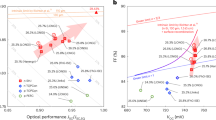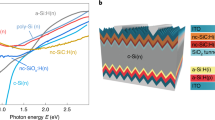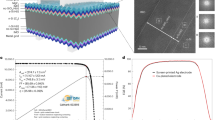Abstract
Silicon heterojunction (SHJ) solar cells are one of the most promising directions in the future photovoltaic industry. The limited supply of rare indium and the high cost of silver paste are among the most important problems that SHJ solar cells will face. To overcome the obstacle of indium-based transparent electrodes for efficient SHJ solar cells, here we successfully prepared cheap and mass-producible undoped tin oxide (SnOx) electrode materials by sputtering at room temperature. Taking advantage of its natural oxygen vacancy defect, the carrier mobility and resistivity of prepared materials reached 22 cm2 V−1 s−1 and 2.38 × 10−3 Ω cm, respectively. The SHJ solar cell with an undoped SnOx front transparent electrode demonstrated an efficiency of 24.91%. Furthermore, SnOx films have excellent chemical stability and can withstand corrosion by acid and alkali solutions during electroplating processes. Finally, SHJ solar cells with plating copper electrode and double-sided indium-based transparent electrodes halved were prepared, and a certified efficiency of 25.94% (total area of 274.4 cm2) was achieved.
This is a preview of subscription content, access via your institution
Access options
Access Nature and 54 other Nature Portfolio journals
Get Nature+, our best-value online-access subscription
$29.99 / 30 days
cancel any time
Subscribe to this journal
Receive 12 digital issues and online access to articles
$119.00 per year
only $9.92 per issue
Buy this article
- Purchase on Springer Link
- Instant access to full article PDF
Prices may be subject to local taxes which are calculated during checkout



Similar content being viewed by others
Data availability
All data generated or analysed during this study are included in the published article and its Supplementary Information. Source data are provided with the paper. Any additional information is available from corresponding authors upon request.
References
Wakisaka, K. et al. More than 16% solar cells with a new ‘HIT’ (doped a-Si/nondoped a-Si/crystalline Si) structure. Conf. Rec. Twenty-Second IEEE Photovolt. Specialists Conf.-1991 2, 887–892 (1991).
Yoshikawa, K. et al. Silicon heterojunction solar cell with interdigitated back contacts for a photoconversion efficiency over 26%. Nat. Energy 2, 17032 (2017).
Razzaq, A., Allen, T. G., Liu, W., Liu, Z. & De Wolf, S. Silicon heterojunction solar cells: techno-economic assessment and opportunities. Joule 6, 514–542 (2022).
Cruz, A. et al. Optoelectrical analysis of TCO+silicon oxide double layers at the front and rear side of silicon heterojunction solar cells. Sol. Energy Mater. Sol. Cells 236, 111493 (2022).
Favier, A., Munoz, D., De Nicolás, S. M. & Ribeyron, P. J. Boron-doped zinc oxide layers grown by metal-organic CVD for silicon heterojunction solar cells applications. Sol. Energy Mater. Sol. Cells 95, 1057–1061 (2011).
Yu, J. et al. Copper metallization of electrodes for silicon heterojunction solar cells: process, reliability and challenges. Sol. Energy Mater. Sol. Cells 224, 110993 (2021).
Minami, T., Suzuki, S. & Miyata, T. Transparent conducting impurity-co-doped ZnO:Al thin films prepared by magnetron sputtering. Thin Solid Films 398, 53–58 (2001).
Min, H. et al. Perovskite solar cells with atomically coherent interlayers on SnO2 electrodes. Nature 598, 444–450 (2021).
Liu, Z. et al. A holistic approach to interface stabilization for efficient perovskite solar modules with over 2,000-hour operational stability. Nat. Energy 5, 596–604 (2020).
Liu, M. et al. SnO2/Mg combination electron selective transport layer for Si heterojunction solar cells. Sol. Energy Mater. Sol. Cells 200, 109996 (2019).
Wang, Q. et al. p-Type c-Si/SnO2/Mg heterojunction solar cells with an induced inversion layer. Appl. Phys. Lett. 119, 263502 (2021).
Yang, G. et al. Defect engineering in wide-bandgap perovskites for efficient perovskite–silicon tandem solar cells. Nat. Photonics 16, 588–594 (2022).
Al-Ashouri, A. et al. Monolithic perovskite/silicon tandem solar cell with > 29% efficiency by enhanced hole extraction. Science 370, 1300–1309 (2020).
Szuber, J., Czempik, G., Larciprete, R., Koziej, D. & Adamowicz, B. XPS study of the L-CVD deposited SnO2 thin films exposed to oxygen and hydrogen. Thin Solid Films 39, 198–203 (2001).
Luo, H., Liang, L. Y., Cao, H. T., Liu, Z. M. & Zhuge, F. Structural, chemical, optical, and electrical evolution of SnOx films deposited by reactive rf magnetron sputtering. ACS Appl. Mater. Interfaces 4, 5673–5677 (2012).
Gu, F. et al. Luminescence of SnO2 thin films prepared by spin-coating method. J. Cryst. Growth 262, 182–185 (2004).
Vanheusden, K., Warren, W. L., Seager, C. H., Tallant, D. R. & Voigt, J. A. Mechanisms behind green photoluminescence in ZnO phosphor powders. J. Appl. Phys. 79, 7983–7990 (1996).
Trani, F., Causà, M., Ninno, D., Cantele, G. & Barone, V. Density functional study of oxygen vacancies at the SnO2 surface and subsurface sites. Phys. Rev. B 77, 245410 (2008).
Tao, Y., Zhu, B., Yang, Y., Wu, J. & Shi, X. The structural, electrical, and optical properties of SnO2 films prepared by reactive magnetron sputtering: Influence of substrate temperature and O2 flow rate. Mater. Chem. Phys. 250, 123129 (2020).
Li, S. et al. Transparent-conductive-oxide-free front contacts for high-efficiency silicon heterojunction solar cells. Joule 5, 1535–1547 (2021).
Dong, G. et al. Power conversion efficiency of 25.26% for silicon heterojunction solar cell with transition metal element doped indium oxide transparent conductive film as front electrode. Prog. Photovolt. Res. Appl. 30, 1136–1143 (2022).
Yu, J. et al. Copper metallization of electrodes for silicon heterojunction solar cells: process, reliability and challenges. Sol. Energy Mater. Sol. Cells 224, 110993 (2021).
Acknowledgements
We thank L. Lv, H. Wu, C. He, Y. Sun and H. Wu for sample fabrication and testing. X.Z. acknowledges financial support from the National Natural Science Foundation of China (grant nos. U21A2072 and 62274099) and the Fundamental Research Funds for the Central Universities (Nankai University). J.Z. and X.C. acknowledge financial support from the Carbon Emission Peak and Carbon Neutrality Special Fund of Jiangsu Province (BA2022205). We acknowledge Haihe Laboratory of Sustainable Chemical Transformations.
Author information
Authors and Affiliations
Contributions
These authors contributed equally: C.Y. and Q.Z. G.D. and X.Z. conceived and directed the overall project. C.Y. and G.D. fabricated all the devices and conducted the characterization. V.A. prepared electroplated copper electrodes and carried out related work. Q.Z. characterized and analysed the materials with the assistance of G.D. and X.Z. Q.Z., Y.Z., X.R., C.-W.P., Q.W., V.A., X.C. and J.Z. contributed to useful discussions. C.Y., Q.Z., G.D. and X.Z. wrote the paper. All authors discussed the results and commented on the paper.
Corresponding authors
Ethics declarations
Competing interests
C.Y., Q.W., Y.Z., X.R., G.D., C.-W.P., X.C. and J.Z. are employees of Suzhou Maxwell Technologies Co., Ltd. V.A. is an employee of SunDrive Solar Pty., Ltd. The other authors declare no competing interests.
Peer review
Peer review information
Nature Energy thanks Martin Bivour and the other, anonymous, reviewer(s) for their contribution to the peer review of this work.
Additional information
Publisher’s note Springer Nature remains neutral with regard to jurisdictional claims in published maps and institutional affiliations.
Supplementary information
Supplementary Information
Supplementary Figs. 1–16, Tables 1–14 and References.
Supplementary Data 1
Source data for Supplementary Fig. 3.
Supplementary Data 2
Source data for Supplementary Fig. 9.
Supplementary Data 3
Source data for Supplementary Fig. 11.
Supplementary Data 4
Source data for Supplementary Fig. 12.
Source data
Source Data Fig. 1
Optical characteristics, Tauc plot, XRD, XPS, PL and J–V data.
Source Data Fig. 2
XPS, electrical characteristics, J–V and EQE data.
Source Data Fig. 3
Photovoltaic parameter data.
Rights and permissions
Springer Nature or its licensor (e.g. a society or other partner) holds exclusive rights to this article under a publishing agreement with the author(s) or other rightsholder(s); author self-archiving of the accepted manuscript version of this article is solely governed by the terms of such publishing agreement and applicable law.
About this article
Cite this article
Yu, C., Zou, Q., Wang, Q. et al. Silicon solar cell with undoped tin oxide transparent electrode. Nat Energy 8, 1119–1125 (2023). https://doi.org/10.1038/s41560-023-01331-7
Received:
Accepted:
Published:
Issue Date:
DOI: https://doi.org/10.1038/s41560-023-01331-7



